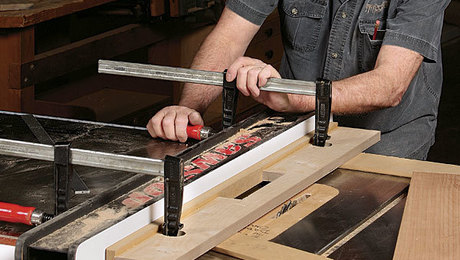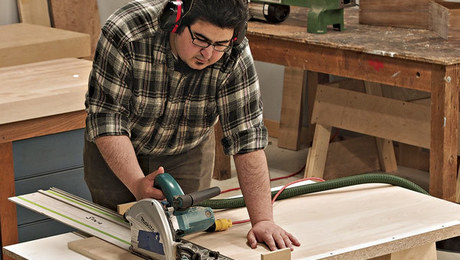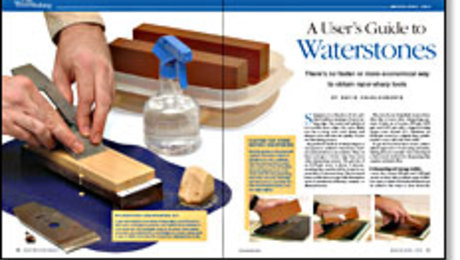STL207: Is woodworking art?–Part 2
Mike, Barry, and Ben discuss crosscutting wide panels, knowing when to sharpen, pinning joinery, and they add a new chapter to the debate–is woodworking art?Question 1:
From Greg:
I’ve been building furniture for about 10 years now and have always had access to the larger machines that your typical “production” shop provides (ie wide belt sander, 16″ jointer, panel saw, etc.). I’m transitioning out on my own and I have a smaller shop set up with your typical machines, including a cabinet saw, and I’m familiar with most of the workarounds for getting the same results with smaller/no machines. I had a question regarding the cross cutting of larger panels though, as it’s an aspect that is always glossed over in articles. Say I’m making a dresser with flat panel sides, 18-21″ deep. Now, I know how tackle the joinery but how do I go about the initial sizing without a panel saw, and how do I achieve repeatable results so my carcass is square? Circ saw? Track saw? Router and straight edge? Special sled? Those all seem like “eyeball” methods that introduce room for error.
 |
|
 |
|
 |
Question 2:
From Len:
Do you have a standard practice, or a routine that works as a sort of automatic set-point or trigger for when to sharpen your planes and chisels, or do you rely on the tactile response of the cutter to let you know it’s time to sharpen?
From George:
For my sharpening setup I use a combination DMT diamond plate and Japanese water stones. I use the 300/600 diamond stone for heavy reshaping work and 1000 and 4000 water stones for the final edge. I also use the 600 side of the diamond plate to lap my water stones before each use. But Back when I ordered my diamond plate I unwittingly purchased one that is slightly smaller than my water stones in length and width. This means that I have to make multiple passes with the diamond plate on top of the water stone in order to fully lap the water stones. Do you think the fact that my diamond plate is smaller than my water stone will eventually lead to them being less and less flat over time or an I worrying for nothing.
 |
Segment: All-Time Favorite Technique of all time for this week
Barry: Use a wooden handscrew as a vise for edge planing
 |
Ben: French polishing
 |
Mike:
Question 3:
From Lois Lane:
Hi, I was listening to episode 58, because I was curious to the answer about is Woodworking considered an art – no it’s not. The reason I ask, is because my brother is a woodworker who I consider an artist and we are having a debate on the subject. He doesn’t want to put it in the art category, because the pieces are mostly functional although aesthetic at the same time. What are your thoughts? Are woodworkers artists?
STL 58: Is Woodworking an Art @15:50
Question 4:
From Gustav from Sweden:
For me, woodworking is all about the process and the joy of working my hands. But, I do like my furniture, and want it to last long into the future. Mostly these days I use dowels in combination with other joinery as a means of locking pieces together. However, since I started listening to STL I have started to doubt how smart it is to use dowels. You guys don’t seem all that positive.
So my questions are:
– Will my furniture fall to pieces?
– Does splines in the dowel help?
– What are some simple alternatives to dowels if one cannot afford a domino or biscuit machine?
 |
Every two weeks, a team of Fine Woodworking staffers answers questions from readers on Shop Talk Live, Fine Woodworking‘s biweekly podcast. Send your woodworking questions to [email protected] for consideration in the regular broadcast! Our continued existence relies upon listener support. So if you enjoy the show, be sure to leave us a five-star rating and maybe even a nice comment on our iTunes page.





















Comments
I disagree with Mike that art can't have a use. Art doesn't have to have a use. It can be stand alone, but the fact that something has a use doesn't mean it isn't art. IMHO.
Check out Jason Lonon's tools, knives, adz, hatchets, nice hand made tools by a talented woodworker.
I haven’t figured out whether to comment here or on youtube yet so I’ll duplicate it.
I think the word art gets used in two ways. It can describe process and it can describe an object. Most custom making involves a combination of both art and craft. Whether a finished piece is, in it’s entirety art, is a more subjective notion but there tends to need to be lots of artistic process in the piece for the finished object to be considered art.
To resolve the riddle of craft being lower but not lower I think that craft is equally honorable but more humble because it subjugates itself to function and accuracy. Art is the creative decisions which come from maker’s own expression while craft is the skills to be able to bring the object into existence and an understanding of the requirements so it can perform it’s function.
In my opinion, perfectly replicating someone else’s creation or design, however beautiful, is skilled craft but not art. Changing the curve in a leg because it’s more to your liking is art. Knowing how to play the clean G chord on a ukulele is craft but deciding how much longer to hold the chord than is written on the page is art. Painting a perfect replica of a photograph of a sunrise is skilled craft while drawing a picture with crayons of your mommy and daddy holding hands next to your dog outside an imaginary house in the country is art
Log in or create an account to post a comment.
Sign up Log in